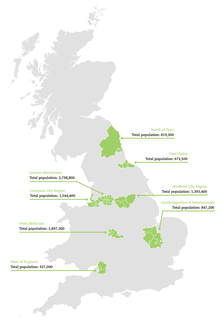City region (United Kingdom)
A city region is the metropolitan area around a city or large town given devolved powers from central government.
The policy that resulted from this was the creation of combined authorities in England with the election of directly elected mayors. There are currently ten such authorities, with the Greater Manchester Combined Authority established on 1 April 2011, four others established in April 2014, two in 2016, two more in 2017 and one in 2018. Combined authorities are created in areas where they are considered likely to improve transport, economic development and regeneration. Combined authorities are created voluntarily and allow a group of local authorities to pool appropriate responsibility and receive certain delegated functions from central government in order to deliver transport and economic policy more effectively over a wider area.
Background
City region is a concept used by economists and urban planners to denote a metropolitan area and its hinterland, usually divided administratively but with shared resources and markets. It originated in a British policy context through Derek Senior's Memorandum of Dissent in the 1969 Redcliffe-Maud Report. Tightly defined areas around major cities became metropolitan counties in 1974, but the elected county governance was abolished in 1986 and replaced with indirectly elected structures such as passenger transport authorities.
In 2004 plans for Regional Assemblies in England were rejected in a referendum by voters in North East England.
The concept of city regions and their development features heavily in The Northern Way, a collaborative development plan between the three northernmost English regional development agencies. Major cities started to collaborate through the Core Cities Group.
The New Local Government Network proposed the creation of city regions as part of on-going reform efforts, while a report released by the IPPR's Centre for Cities proposed the creation of four large city-regions based on Birmingham , Leeds, Liverpool and Greater Manchester.
A report submitted to the Welsh Assembly recommended the creation of two city regions in South Wales, the Swansea Bay City Region centred on Swansea (region population: 685,051), and the far larger Cardiff Capital Region centred on Cardiff (region population: 1,400,000).[1][2]
City regions are wider than urban areas used by the Office for National Statistics, but narrower than the regions defined by Nomenclature of Territorial Units for Statistics (NUTS).
Policy

In July 2007, HM Treasury published its Review of sub-national economic development and regeneration, which stated that the government would allow those city regions that wished to work together to form a statutory framework for city regional activity, including powers over transport, skills, planning and economic development.[3]
In the April 2009 Budget, the government announced that Greater Manchester and Leeds would be the first two city regions with formal powers.[4] While this was later discontinued as a result of the May 2010 general election, the Conservative–Liberal Democrat coalition government did agree to the creation of the Greater Manchester Combined Authority in 2011. Several of the 'city deals' agreed between the Cabinet Office/Department for Communities and Local Government in 2012 included city regional working at their core, including new combined authorities.[5]
There are three stages to the development of a combined authority for a city region. Firstly a review must be undertaken to establish the likelihood that a combined authority would improve:
"...the exercise of statutory functions relating to transport in the area, the effectiveness and efficiency of transport in the area, the exercise of statutory functions relating to economic development and regeneration in the area, and economic conditions in the area."
— Local Democracy, Economic Development and Construction Act 2009, Part 6[6]
On completion of the review the city region and hinterland authorities produce and publish a proposed scheme of the metropolitan combined authority to be created, including the area that will be covered, the constitution and functions. This will include details of membership of the authority, remuneration, and how meetings will be chaired and recorded. Following a period of consultation and subject to the approval of the Secretary of State for Communities and Local Government, the combined authority is formally created, and city region powers from central government by a statutory instrument.
Created
Not every city region may be suitable, economically or geographically, for devolution and as such only a select few have been granted such ─ these are listed in the table below.
See also
References
- "'City regions' set for Cardiff and Swansea to boost prospects". BBC News. Retrieved 30 October 2015.
- Sion Barry (27 March 2014). "Cardiff to feature in name for city region covering South-East Wales". walesonline. Retrieved 30 October 2015.
- "Sub-national economic development and regeneration review". HM Treasury. 17 July 2007. Archived from the original on 29 January 2013. Retrieved 14 December 2015.
- Budget 2009: Economic and Fiscal Strategy Report Archived 2009-07-11 at the Wayback Machine para 4.48
- City Deals Cabinet Office website
- "Local Democracy, Economic Development and Construction Act 2009". Retrieved 11 August 2012.
- "Combined Authority economic indicators". Office for National Statistics. 14 March 2017.
- "The Greater Manchester Combined Authority Order 2011". Retrieved 11 August 2012.
- "The Halton, Knowsley, Liverpool, St Helens, Sefton and Wirral Combined Authority Order 2014".
- "The Barnsley, Doncaster, Rotherham and Sheffield Combined Authority Order 2014".
- "The Tees Valley Combined Authority Order 2016". Statutory Instrument No. 449 of 29 March 2016.
- "The West of England Combined Authority Order 2017", legislation.gov.uk, The National Archives, SI 2017/126
- "The Cambridgeshire and Peterborough Combined Authority Order 2017", legislation.gov.uk, The National Archives, SI 2017/251
.svg.png)